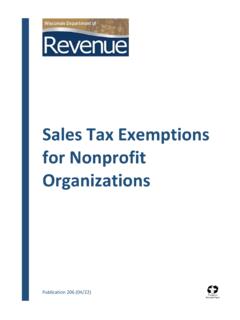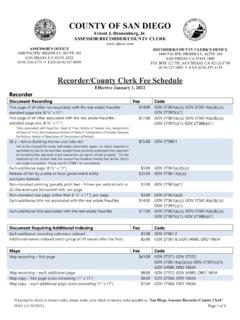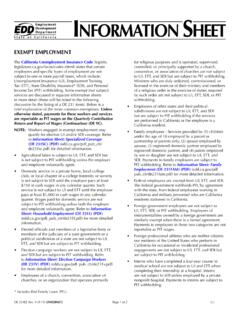Transcription of Tax Exempt & Government Entities Group Exemptions
1 Group Exemptions Tax Exempt and Government Entities Division What is a Group exemption letter? The IRS sometimes recognizes a Group of or-ganizations as tax- Exempt if they are affiliated with a central organization. This avoids the need for each of the organizations to apply for exemption individually. A Group exemp-tion letter has the same effect as an individualexemption letter except that it applies to more than one organization. What is the reason for Group Exemptions ? Group Exemptions are an administrative convenience for both the IRS and organiza-tions with many affiliated organizations. Sub-ordinates in a Group exemption do not have to file, and the IRS does not have to process, separate applications for exemption .
2 Conse-quently, subordinates do not receive individual exemption letters. What types of organizations can qualify for Group Exemptions ? Exempt organizations that have or plan to have related organizations that are very similar to each other may apply for a Group exemption . What are central and subordinate organizations? Groups of organizations with Group exemption letters have a head or main organization, referred to as a central organization. The central organization generally supervises or controls many chapters, called subordinate organizations. The subordinate organizations typically have similar structures, purposes, and activities. Example: X is a national, fraternal organization Exempt under Internal Revenue Code ( IRC ) section 501(c)(8).
3 X has several state and hundreds of local chapters that have nearly identical articles of incorporation, by-laws, pur-poses, and activities. As the national organization, X is considered the central organization; the state and local chap-ters are subordinate organizations and are covered under X s Group exemption . What criteria must organizations meet to be included in a Group exemption ? To qualify for a Group exemption , the central organization and its subordinates must have a defined relationship. Subordinates must be: Affiliated with the central organization; Subject to the central organization s gen-eral supervision or control; and Exempt under the same paragraph of IRC 501(c), though not necessarily the paragraph under which the central orga-nization is Exempt .
4 Rev. Proc. 80-27, 1980-1 677 sets forth additional criteria. Must the central organization be recognized by the IRS as tax- Exempt before the organization can obtain a Group exemption ? No. A central organization may submit its re-quest for a Group exemption at the same time it submits its exemption application on Form 1023 or Form 1024. Although churches are not required to apply for recognition of their own status in order to be tax- Exempt , under the procedures for Group rulings, a church must request recognition of its own Exempt status in order to be the central organization in a Group ruling. Are there any special rules for churches? With limited exceptions, churches are subject to the same general requirements relating to Group rulings as other organizations.
5 How-ever, churches are not required to file annual updates notifying the IRS of changes in the composition of the Group . Where does a central organization apply for exemption and submit a request for a Group exemption ? A central organization sends its application for exemption , the request for a Group exemption , and the required user fee, to: Internal Revenue Service Box 192 Covington, KY 41012-0192 Or, if using express mail or a delivery service, to: Internal Revenue Service 201 West Rivercenter Blvd. Attn: Extracting Stop 312 Covington, KY 41011 What must a request for a Group exemption contain? The central organization submits a letter to the IRS on behalf of itself and its subordi-nates.
6 The letter includes: a. Information verifying the existence of the required relationship; b. A sample copy of a uniform governing in-strument (such as a charter, trust indenture, articles of association, etc.) adopted by the subordinates; c. A detailed description of the purposes and activiti es of the subordinates including the sources of receipts and the nature of expen-ditures; d. An affirmation by a principal officer that, to the best of the officer s knowledge, the purposes and activities of the subordinates are as set forth in (b) and (c) above; e. A statement that each subordinate to be included in the Group exemption letter has furnished written authorization to the central organization; f.
7 A list of subordinates to be included in the Group exemption letter to which the IRS has issued an outstanding ruling or determina-tion letter relating to exemption ; g. If the application for a Group exemption letter involves IRC 501(c)(3), an affirmation to the effect that, to the best of the officer s knowledge and belief, no subordinate to be included in the Group exemption letter is a private foundation as defined in IRC 509(a); h. For each subordinate that is a school claim-ing exemption under IRC 501(c)(3), the information required by Rev. Proc. 75-50, 1975-2 834 and Rev. Rul. 71-447, 1971-2 230; and i. A list of the names, mailing addresses (including zip code), actual addresses (if dif-ferent), and employer identification numbers of subordinates to be included in the Group exemption letter.
8 A current directory of subordinates may be furnished in lieu of the list if it includes the required information and if the subordinates not to be included in the Group exemption letter are identified. The rules for applying for a Group exemption are set forth in Rev. Proc. 80-27, 1980-1 677. How does the Group exemption process work? Upon receipt of an application Form 1023 or 1024 and a request for Group exemption , the IRS first determines whether the central organization and the existing subordinates qualify for tax exemption . Once the IRS grants the exemption , the central organiza-tion is responsible for: (1) ensuring that its current subordinates continue to qualify to be Exempt ; (2) verifying that any new sub-ordinates are Exempt ; and (3) updating the IRS on an annual basis of new subordinates, subordinates no longer to be included, and subordinates that have changed their names or addresses.
9 What is included in an annual update? Annual updates must contain the following information: a. Information about changes in purposes, ch aracter, or method of operation of sub-ordinates included in the Group exemption letter. b. Lists of : 1. subordinates that have changed their names or addresses during the year; 2. subordinates no longer to be included in the Group exemption letter because they have ceased to exist, disaffiliated, or withdrawn their authorization to the central organization; and 3. subordinates to be added to the Group exemption letter because they are newly organized or affiliated or have newly authorized the central organiza-tion to include them.
10 Each list must show the names, mailing ad dress (including zip codes), actual ad-dress if different, and employer identifica-tion numbers of the affected subordinates. An annotated directory of subordinates will not be accepted for this purpose. If none of these changes occurred, the central or-ganization must submit a statement to that effect. c. The same information about new subordi-nates that was required in the initial re-quest. If a new subordinate does not differ in any material respects from the subor-dinates included in the original request, however, a statement to this effect may be submitted in lieu of detailed information. Where does a central organization submit an annual update?
















